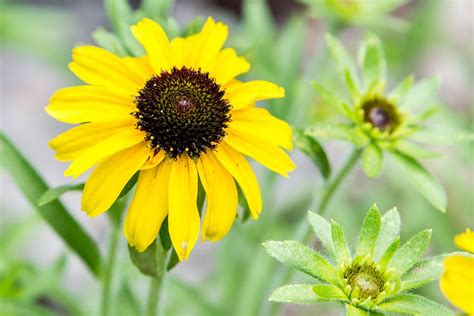How To Grow And Care For A Black Eyed Susan Plant
Black-eyed Susans are a beloved and popular plant amongst gardeners, and for good reason. These gorgeous flowers are easy to grow and care for, making them a perfect addition to anyone's garden. In this article, we'll go over everything you need to know about planting, growing, and caring for black-eyed Susans. Plant Attributes Black-eyed Susans, also known as Rudbeckia hirta, are part of the sunflower family, making them a hardy and resilient plant. They typically grow to be about 2-3 feet tall and 1-2 feet wide, with bright yellow petals and a distinct dark center. These plants typically bloom in mid to late summer and will continue to flower until the first frost. One thing that sets black-eyed Susans apart from other plants is their ability to attract butterflies and bees to your garden. This is thanks to the nectar and pollen these flowers produce, making them a vital part of any pollinator garden. Plant Care Black-eyed Susans are relatively low-maintenance plants, but they still require proper care to thrive. These are some essential steps you should follow to ensure your black-eyed Susans stay healthy: 1. Soil: These plants prefer well-draining soil that is slightly acidic. 2. Watering: Black-eyed Susans prefer consistent watering, but they can tolerate drought once established. They don't like to be overwatered, so make sure the soil has time to dry out between waterings. 3. Fertilizer: These plants don't require much fertilizer, but you can use a general-purpose fertilizer in the spring to give them a boost. 4. Sun Exposure: Black-eyed Susans prefer full sun, but they can tolerate partial shade. Pruning Black-eyed Susans don't require a lot of pruning, but deadheading them can encourage more blooms. Deadheading is the process of removing spent flowers to encourage new growth. You can do this by simply pinching off the dead flower heads or cutting the stem below the spent flowers. Propagation Black-eyed Susans are easy to propagate through division or by starting seeds indoors. Dividing your plants every three to four years will not only produce new plants but will also help ensure the health of your existing plants. When starting seeds indoors, plant them about six weeks before the last expected frost. Potting & Repotting Black-eyed Susans can be grown in containers but require proper drainage. When repotting, make sure to choose a pot that is at least 2 inches wider than the current pot. Common Pests & Plant Disease Black-eyed Susans are generally pest and disease-free, but they can occasionally be affected by spider mites, thrips, or powdery mildew. These issues can be prevented by promoting good air circulation around the plants and avoiding overcrowding. Common Problems Overwatering black-eyed Susans can cause root rot, which can lead to the death of the plant. Avoid this issue by letting the soil dry out between waterings. Black-eyed Susans also don't like to be crowded, so make sure to space them at least a foot apart. In conclusion, black-eyed Susans are a beautiful and easy-to-care-for plant that can provide your garden with a bright and bold burst of color. By following the plant attributes, proper plant care, pruning, propagation, potting and repotting, as well as knowledge on pest and plant disease and common problems; you can ensure the health and longevity of your black-eyed Susans. Happy Gardening! 


www.elizabethton.com - susans almanac noirs yeux elizabethton mathematics sunlight blackeyed perennials blooms rudbeckia
www.pinterest.com - eyed
www.thespruce.com - susan susans rudbeckia




Post a Comment for "How To Grow And Care For A Black Eyed Susan Plant"